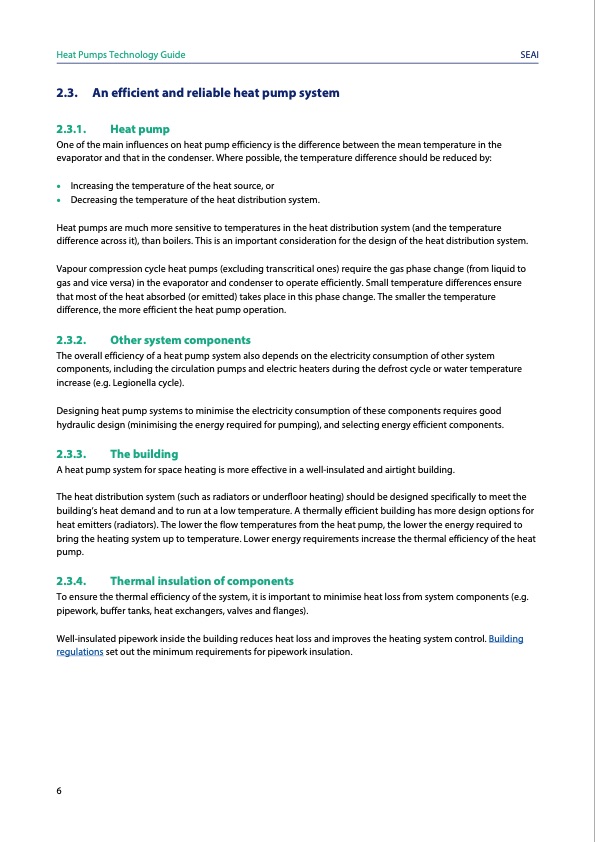
PDF Publication Title:
Text from PDF Page: 010
Heat Pumps Technology Guide SEAI 2.3. An efficient and reliable heat pump system 2.3.1. Heat pump One of the main influences on heat pump efficiency is the difference between the mean temperature in the evaporator and that in the condenser. Where possible, the temperature difference should be reduced by: • Increasing the temperature of the heat source, or • Decreasing the temperature of the heat distribution system. Heat pumps are much more sensitive to temperatures in the heat distribution system (and the temperature difference across it), than boilers. This is an important consideration for the design of the heat distribution system. Vapour compression cycle heat pumps (excluding transcritical ones) require the gas phase change (from liquid to gas and vice versa) in the evaporator and condenser to operate efficiently. Small temperature differences ensure that most of the heat absorbed (or emitted) takes place in this phase change. The smaller the temperature difference, the more efficient the heat pump operation. 2.3.2. Other system components The overall efficiency of a heat pump system also depends on the electricity consumption of other system components, including the circulation pumps and electric heaters during the defrost cycle or water temperature increase (e.g. Legionella cycle). Designing heat pump systems to minimise the electricity consumption of these components requires good hydraulic design (minimising the energy required for pumping), and selecting energy efficient components. 2.3.3. The building A heat pump system for space heating is more effective in a well-insulated and airtight building. The heat distribution system (such as radiators or underfloor heating) should be designed specifically to meet the building’s heat demand and to run at a low temperature. A thermally efficient building has more design options for heat emitters (radiators). The lower the flow temperatures from the heat pump, the lower the energy required to bring the heating system up to temperature. Lower energy requirements increase the thermal efficiency of the heat pump. 2.3.4. Thermal insulation of components To ensure the thermal efficiency of the system, it is important to minimise heat loss from system components (e.g. pipework, buffer tanks, heat exchangers, valves and flanges). Well-insulated pipework inside the building reduces heat loss and improves the heating system control. Building regulations set out the minimum requirements for pipework insulation. 6PDF Image | Heat Pumps Technology Guide

PDF Search Title:
Heat Pumps Technology GuideOriginal File Name Searched:
Heat-Pump-Technology-Guide.pdfDIY PDF Search: Google It | Yahoo | Bing
CO2 Organic Rankine Cycle Experimenter Platform The supercritical CO2 phase change system is both a heat pump and organic rankine cycle which can be used for those purposes and as a supercritical extractor for advanced subcritical and supercritical extraction technology. Uses include producing nanoparticles, precious metal CO2 extraction, lithium battery recycling, and other applications... More Info
Heat Pumps CO2 ORC Heat Pump System Platform More Info
| CONTACT TEL: 608-238-6001 Email: greg@infinityturbine.com | RSS | AMP |